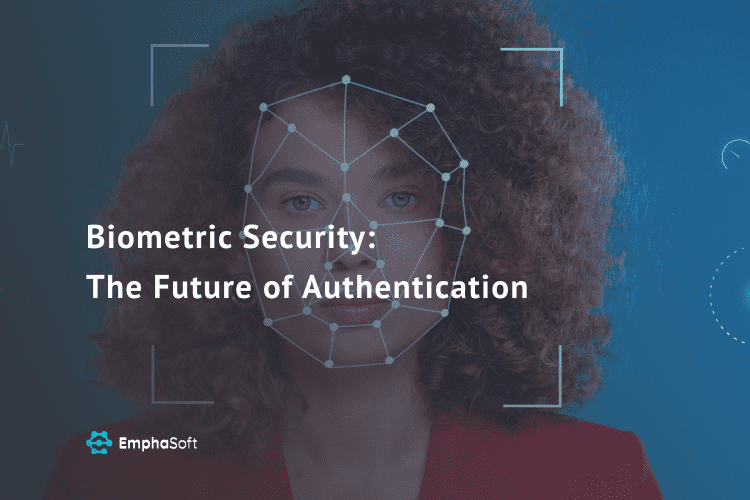
Scale faster with quality tech expertise
As the world continues to migrate to the digital space, traditional authentication methods, such as simple passwords, PINs, and security tokens become insufficient. With cybercrime becoming more advanced daily, our need to stay protected against all kinds of malicious activities increases too.
Biometric authentication can be the answer to our security concerns.
First perceived as something from a James Bond movie, biometric authentication methods have swiftly transitioned into our daily lives. Whenever we enter the airport, our faces are scanned by CCTV. When we apply for a visa, our fingerprints are taken and stored in the database. And before Apple shifted to facial recognition, we were all pressing our fingers against an iPhone to gain access.
Statista predicts the biometric authentication industry will reach 99.6 billion dollars by 2027, which should come as no surprise to anyone. Fortune Business Insights reports a growing interest in biometrics beyond the traditional scope of use, such as to prevent crime. The travel industry along with the automotive and consumer electronic sectors are keen on implementing multi-factor authentications and demonstrate a growing interest in the technology.
The biometric authentication niche is comparatively harder to enter than other markets, but the demand is there, and investors are eager to sponsor new ventures. That’s why this technology continues to be one of the top options for tech startups.
Today we will take a closer look at biometric authentication, what it entails, future trends, potential downsides, and the ethical side of implementing it widely.
What types of biometric authentication technologies exist today?
Biometric authentication relies on the use of our unique biological characteristics. The main biometric identifiers that are used today are:
This form of biometric recognition requires minimum effort from the end user’s side, and is often used in call centres to improve the quality of service and expedite issue resolution.
Considered one of the most reliable methods, iris and retina recognition dates back to the 1990s when John Dufman patented the detecting algorithm and encouraged its use.
One of the oldest identifiers, along with fingerprints, is often criticised as unreliable because our handwriting patterns change and hand injuries can prevent someone from using it. That’s why handwriting is primarily used for activities that require low-level security.
- Fingerprint. Launching in law enforcement, fingerprints have entered our everyday lives with millions using it to access not only their laptops and smartphones, but also offices and residencies. Theearliest evidence of using fingerprints as an authentication method, however, dates back to 500 B.C. Babylon.
- Face. Face recognition is another method that was widely popularised by law enforcement. Today, it continues to be used by agencies to spot criminals and ensure everyone’s safety, but it is also applied in accessing our personal equipment, and assisting low-vision and blind individuals. Yet, despite all the benefits, facial recognition is one of the most condemned technologies because of lack of regulation and seemingly unlimited control with cases like in China not helping the cause become more tolerated.
- Voice. This form of biometric recognition requires minimum effort from the end user’s side, and is often used in call centres to improve the quality of service and expedite issue resolution.
- Iris and retina. Considered one of the most reliable methods, iris and retina recognition dates back to the 1990s when John Dufman patented the detecting algorithm and encouraged its use.
- Handwriting. One of the oldest identifiers, along with fingerprints, is often criticised as unreliable because our handwriting patterns change and hand injuries can prevent someone from using it. That’s why handwriting is primarily used for activities that require low-level security.
There are also more exotic identifiers, such as vein patterns and gestures but they are not as widely utilised as of yet.
Good or bad? The advantages and challenges of biometric authentication
Biometric authentication is fascinating, but like any other technology, it has its upsides and downsides. Let’s look at them together.
Advantages of biometric authentication
The use of biometric authentication can make our lives better and more secure through:
- Enhanced security using unique biological features.
Faking a password is much easier than imitating someone’s retina or a fingerprint, despite what spy movies make you believe. At the moment, this is the most secure way of authentication and the best way to safeguard your personal and business assets. And the use of multiple biometric and traditional authentication methods is an even better way to stay protected. - User convenience and reduction of password-related issues.
Unlike passwords that have to be changed, updated, and remembered, your voice or fingerprints remain the same throughout your lifetime. And since they are unique to every individual person, there is significantly less hassle with keeping your security measures up-to-date. There is also no risk of forgetting your credentials, which often creates a mess and causes all sorts of delays and issues to the person whose mind they slipped. - Potential for multi-factor authentication systems.
First, we started with passwords, and then two-factor authentication (2FA) was introduced as an extra layer of security. Next came biometrics, creating a proper multi-factor authentication system. While you don’t need to use all these steps for every single service you use, things like banking and personal finance in general and medical assistance are fields where multi-level security is not merely nice addition but a necessity.
Challenges of biometric authentication
- Privacy concerns and ethical implications of biometric data storage.
Whenever vast amounts of personal data are stored, it raises privacy concerns, and rightfully so. Biometric data is so unique and presents so much value that it makes us question who has the authority to store and handle it. From private criminals to corrupt governments – many parties would be seeking ways to access the data and use it to their own advantage which is a huge risk on both personal and national levels. - Vulnerabilities to spoofing and presentation attacks.
Identity theft is an ever-rising issue that many of the latest technologies are designed to prevent, yet become a contributing factor to the problem. Startups and enterprises that are looking at implementing or developing biometric authentication are expected to address the risk of spoofing which is becoming more advanced day by day. - Legal and regulatory challenges related to biometric authentication.
Regulators are notoriously slow at recognising new technologies and making progress with legislation. While international standards are already being developed, there is still no solid process for safety control and the repercussions for misuse of the technology are mostly in the hands of local institutions that are not necessarily equipped to deal with such cases at all.
What does the future hold for biometric authentication?
Sadly, the level of crime and fraud is not likely to slow down, and in search of better ways to protect themselves, companies and individuals alike will continue to implement any technology they can find. Biometric authentication will lead the way as things like fingerprints and iris patterns are much harder to fake and misuse.
However, it’s also important to note that with advances in AI, machine learning, and deep fakes, the industry will certainly face its challenges in differentiating the true from the false.
The ethics and security of biometric authentication
Similarly to other disruptive technologies, such as artificial intelligence and blockchain, biometric authentication has to be monitored closely. There are lots of implications of utilising it that we are not aware of yet. That’s why whatever we do, we must consider the ethical side of implementing it and evaluate just how secure it really is.
Biometrics are great at preventing fraudulent access to services and locations, but in the wrong hands, they can quickly turn our lives into a Black Mirror episode. The question of who has the right to store and utilise such extremely sensitive data remains open. Guidelines for the development of the technology, as well as collection, use, and storage of information, must be developed and implemented, despite it not always being clear how to identify and track wrongful practices.
Not less important is the question of security. Any biometric data that is stored needs to be encrypted, and whenever it is transferred, additional protection measures must be implemented. As an extremely challenging task, biometrics protection will be one of the key focuses of the industry, and any startup offering a sensible solution will have no trouble generating investor interest and funds to expand their development.
Read next:
Case Studies: Face recognition platform
Data security: how can companies protect their and clients’ data
Case Studies: AI and computer vision platform for facial recognition
Biometrics are great at preventing fraudulent access to services and locations, but in the wrong hands, they can quickly turn our lives into a Black Mirror episode. The question of who has the right to store and utilise such extremely sensitive data remains open. Guidelines for the development of the technology, as well as collection, use, and storage of information, must be developed and implemented, despite it not always being clear how to identify and track wrongful practices.








 Schedule a Discovery Call
Schedule a Discovery Call Schedule Call
Schedule Call